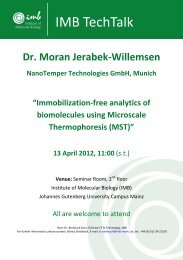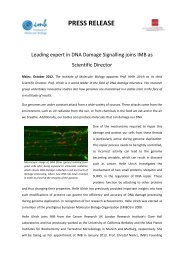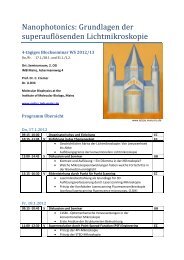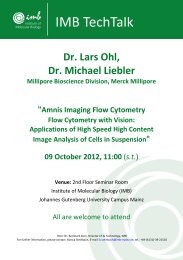Low-resolution PDF - IMB
Low-resolution PDF - IMB
Low-resolution PDF - IMB
You also want an ePaper? Increase the reach of your titles
YUMPU automatically turns print PDFs into web optimized ePapers that Google loves.
M o d e l l i n g o f B i o l o g i c a l N e t w o r k s<br />
8 “New therapeutic approaches for<br />
cancer must take network<br />
structures into account.”<br />
Stefan<br />
Legewie<br />
Education<br />
2004 Diploma in Biochemistry, University of Witten/Herdecke<br />
2008 PhD in Biophysics, Humboldt University Berlin<br />
Positions held<br />
2008 - 2009 Postdoctoral Researcher,<br />
Institute for Theoretical Biology,<br />
Humboldt University Berlin<br />
2009 - 2010 Group Leader ‘Theoretical Systems Biology’,<br />
Department of Theoretical Bioinformatics,<br />
German Cancer Research Center (DKFZ), Heidelberg<br />
Since 2010<br />
Group Members<br />
Group Leader, Institute of Molecular Biology (<strong>IMB</strong>),<br />
Mainz<br />
Stephan Baumgärtner / PhD student; since 11/2011<br />
Bhashar Gosh / Visiting Postdoc; 12/2012 - 02/2013<br />
Lu Huang / Postdoc; since 10/2012<br />
Matthias Jeschke / Postdoc; since 07/2011<br />
Monika Kuban / Research Assistant; since 10/2012<br />
Tamara Milhaljev / Postdoc; since 11/2010<br />
Uddipan Sarma / Postdoc; since 08/2012<br />
Research Overview<br />
Our group employs mathematical modelling to gain insights into the<br />
dynamics of biological networks. Data-based models are developed in<br />
close collaboration with experimental partners, and model predictions<br />
are verified using wet lab experiments. Our research focusses on cellto-cell<br />
variability in cellular signal transduction and on quantitative<br />
modelling of gene expression responses.<br />
Research Highlights<br />
Modelling gene regulatory networks<br />
One of the major focuses of our group is the quantitative modelling<br />
of gene regulation. We use various modelling approaches to describe<br />
different aspects of this process. Network models taking into account<br />
the wiring of many genes are derived based on large-scale datasets.<br />
We also study small genetic modules, and use models to describe<br />
mechanistic details at the single promoter level.<br />
Gene expression responses to external stimulation are coordinated<br />
by complex networks of transcription factors. The wiring and the dynamics<br />
of such networks are incompletely understood. We characterized<br />
a medium-scale transcription factor response that mediates oncogenic<br />
transformation upon overexpression of oncogenic Ras (Stelniec-Klotz<br />
et al. 2012). The network dynamics were analysed by systematically<br />
perturbing transcription factor levels, and subsequently measuring<br />
gene expression responses. A mathematical model was applied to<br />
distinguish direct and indirect perturbation effects. As a result, regulatory<br />
interactions within the network could be reconstructed from<br />
the data and the wiring of the network controlling tumour growth<br />
clarified. The model-predicted network structure was validated experimentally<br />
using double perturbation experiments as well as phenotypic<br />
analyses. Contrary to current assumptions, the results show that no<br />
superordinate transcription factor exists that controls the activity of<br />
other factors as a master regulator. Instead, two hierarchical groups of<br />
interacting factors exist. Each of them activates gene sets needed for<br />
the growth and cancer-specific properties of the cells. The results indicate<br />
that new therapeutic approaches against tumours must target<br />
multiple rather than single factors and consider network structures.










